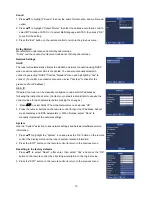
14
APPENDIX 1 DTV Channel Table Information
*Log on to the website http://www.antennaweb.org
and select “Choose An Antenna”. Enter your address
and find the DTV stations airing the signal in your local area and then visit the local station websites for
program schedules. Usually the website names are t
he same as the station’s name. For example, DTV
station WCBS (channel 56) New York’s website is http://www.wcbs.com
and KCET (UHF channel 59)
Los Angeles’s website is http://www.kcet.org.
However, the most accurate me
thod for locating the local station’s website is through their parent
network. For example, to find WCBS New York, check the CBS website. You can also contact the
network service center for detailed information about their local DTV program package.
Note:
(a) Using the Antenna Web site, you can also get information about choosing the correct type of
antenna and the proper aiming guidelines.
(b) NAB (Association of Broadcasters) has updates on the local DTV stations in operation at
http://www.nab.org/Newsroom/Issues/digitaltv/DTVstations.asp
APPENDIX 2 RF System Guidelines
This section is a basic guideline based on the SCTE Digital Cable Network Standard. For optimal performance on a
cable system following the published standards will usually lead to the best results and the least headaches. More
detailed documents are available from the standards committees.
Analog and Digital Channel: RF Transmission Characteristics
1. RF Channel Spacing 6 MHz
2. RF Frequency Range 54 MHz to 864 MHz IRC/HRC/Standard Channel Plans.
3. Transit delay from head-end to most distant customer < 0.800 ms (typically much less)
4. Carrier-to-noise ratio, C/(N+I), in a 6-MHz band where C/(N+I) includes the simultaneous presence of all additive
impairments in the 6-MHz channel bandwidth including CTB, CSO, other discrete interference.
C/N (analog channels)
Not less than
27 dB for 64 QAM;
33 dB for 256 QAM;
43 dB for AM-VSB analog
5. CTB Not worse than -53 dBc referenced to in-band carrier levels for analog channels.
6. CSO Not worse than -53 dBc referenced to in-band carrier levels for analog channels.
7. Carrier-to-any other discrete interference (ingress). Not worse than -53 dBc
8. AM Hum Modulation Not greater than 3% p-p
9. Group Delay Variation < 0.25 µsec/MHz across the 6-MHz channel
10. Chroma / Luma Delay ≤ 170 ns (AM-VSB analog)
11. Phase Noise < -88 dB/Hz @ 10 kHz offset (relative to the center of QAM signal spectrum)
12. Maximum amplitude variation across the 6-MHz channel (digital channels)
Содержание V-Tune Pro VPH-100
Страница 1: ...Manual Number 120223...
Страница 26: ...23...










































